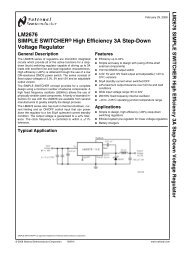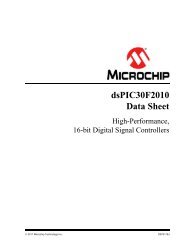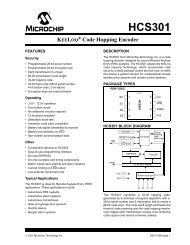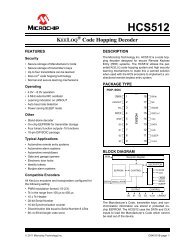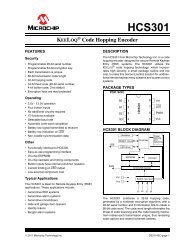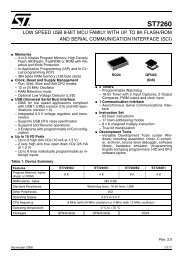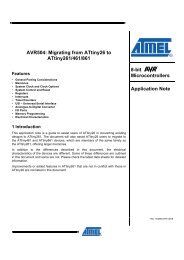You also want an ePaper? Increase the reach of your titles
YUMPU automatically turns print PDFs into web optimized ePapers that Google loves.
Radio frequency module<br />
<strong>STM32W108C8</strong><br />
5 Radio frequency module<br />
The radio module consists of an analog front end and digital baseband as shown in<br />
Figure 1: <strong>STM32W108C8</strong> block diagram.<br />
5.1 Receive (Rx) path<br />
The Rx path uses a low-IF, super-heterodyne receiver that rejects the image frequency<br />
using complex mixing and polyphase filtering. In the analog domain, the input RF signal<br />
from the antenna is first amplified and mixed down to a 4 MHz IF frequency. The mixers'<br />
output is filtered, combined, and amplified before being sampled by a 12 Msps ADC. The<br />
digitized signal is then demodulated in the digital baseband. The filtering within the Rx path<br />
improves the <strong>STM32W108C8</strong>'s co-existence with other 2.4 GHz transceivers such as IEEE<br />
802.15.4, IEEE 802.11g, and Bluetooth radios. The digital baseband also provides gain<br />
control of the Rx path, both to enable the reception of small and large wanted signals and to<br />
tolerate large interferers.<br />
5.1.1 Rx baseband<br />
The <strong>STM32W108C8</strong> Rx digital baseband implements a coherent demodulator for optimal<br />
performance. The baseband demodulates the O-QPSK signal at the chip level and<br />
synchronizes with the IEEE 802.15.4-defined preamble. An automatic gain control (AGC)<br />
module adjusts the analog gain continuously every ¼ symbol until the preamble is detected.<br />
Once detected, the gain is fixed for the remainder of the packet. The baseband despreads<br />
the demodulated data into 4-bit symbols. These symbols are buffered and passed to the<br />
hardware-based MAC module for packet assembly and filtering.<br />
In addition, the Rx baseband provides the calibration and control interface to the analog Rx<br />
modules, including the LNA, Rx baseband filter, and modulation modules. The ST RF<br />
software driver includes calibration algorithms that use this interface to reduce the effects of<br />
silicon process and temperature variation.<br />
5.1.2 RSSI and CCA<br />
The <strong>STM32W108C8</strong> calculates the RSSI over every 8-symbol period as well as at the end<br />
of a received packet. The linear range of RSSI is specified to be at least 40 dB over<br />
temperature. At room temperature, the linear range is approximately 60 dB (-90 dBm to -30<br />
dBm input signal).<br />
The <strong>STM32W108C8</strong> Rx baseband provides support for the IEEE 802.15.4-2003 RSSI CCA<br />
method, Clear channel reports busy medium if RSSI exceeds its threshold.<br />
5.2 Transmit (Tx) path<br />
The <strong>STM32W108C8</strong> Tx path produces an O-QPSK-modulated signal using the analog front<br />
end and digital baseband. The area- and power-efficient Tx architecture uses a two-point<br />
modulation scheme to modulate the RF signal generated by the synthesizer. The modulated<br />
RF signal is fed to the integrated PA and then out of the <strong>STM32W108C8</strong>.<br />
29/215 Doc ID 018587 Rev 2





